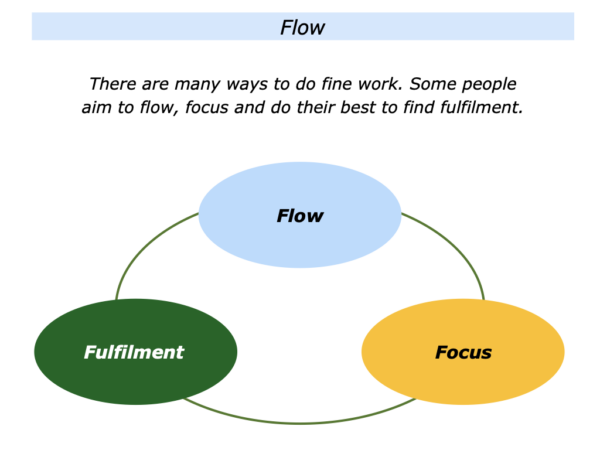
There are many ways to fine work. Some people aim to follow the flow approach. They aim to flow, focus, do fine work, finish and sometimes find fulfilment.
Different people pursue this approach in different ways. They may follow it when encouraging people, doing creative work, playing a sport or doing another activity.
Mihaly Csikszentmihalyi did much of the pioneering work on flow. He described his findings in books such as Flow: The psychology of optimal experience and Creativity: Flow and the psychology of discovery and invention.
Before Mihaly’s work some people talked about flow in terms of being in the zone or having peak experiences. Timothy Gallwey also touched on these themes with his books on The Inner Game of Tennis and also Inner Skiing.
Mihaly says that flow experiences are those where you become completely absorbed in an activity and time goes away.
You start by tackling a stimulating task that you have a chance of completing. Setting clear goals, you embark on the work. You feel a sense of control, concentrate and get immediate feedback.
Becoming absorbed in the task, you experience a deep and effortless involvement that removes the frustrations of everyday life. The experience is so enjoyable that time goes away.
Your sense of self disappears when doing the task but afterwards you emerge stronger. Mihaly explains this in the following way in his writing.
We have all experienced times when, instead of being buffeted by anonymous forces, we do feel in control of our actions, masters of our own fate.
On the rare occasions that it happens, we feel a sense of exhilaration, a deep sense of enjoyment that is long cherished and that becomes a landmark in memory for what life should be like.
The best moments usually occur when a person’s body or mind is stretched to its limits in a voluntary effort to accomplish something difficult and worthwhile.
Optimal experience is therefore something that we make happen.
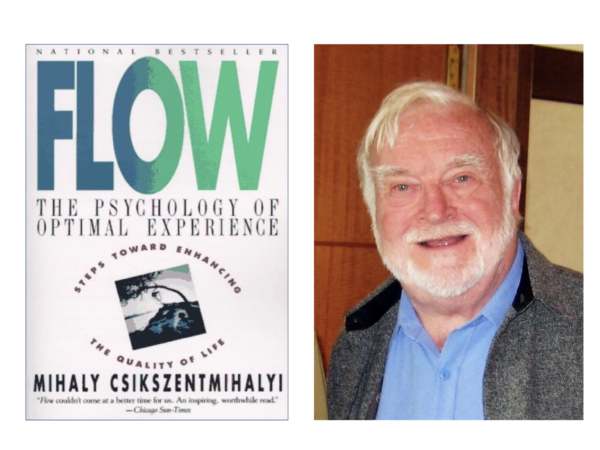
The following pages explore one framework that people can follow to flow, focus, finish and find fulfilment. There are, of course, several parts to each of these stages. Let’s explore these themes.
Flow
Looking at your own life, when do you experience a sense of flow? You may do this when encouraging a person, gardening, painting, cooking, dancing, playing music, riding a horse, solving a certain kind of problem or doing another activity.
Later we will look at how you can do more of these things in the future. Before then, however, let’s explore what inspired Mihaly to study this concept.
He was born in Rijecka, Croatia. His family was Hungarian, and his father Alfred, a diplomat, had been posted to Italy. Living in cities such as Rome and Florence exposed Mihaly to different cultures and he became fluent in Hungarian, Italian and German.
Despite being a child, he was interned in Italy for a while and tried to make sense of events. Interviewed years later by Dava Sobel for Omni Magazine, he explained this in the following way.
“As a child in World War 2 Europe, I was dismayed to find that grown-ups had no idea what was going on and were helpless to extricate themselves from the mess they had created.
“I resolved to figure out how one could live a better life. I tried many things, such as art, fiction, philosophy and working in youth organisations.
“I discovered psychology through the writings of C.J. Jung, and thought that perhaps this was the best way to understand behaviour and history. I can’t say I have, but in the process I learned a lot and had a good time.”
Travelling to Switzerland when he was around 16, Mihaly heard Carl Jung lecture about the human soul and this had a profound effect on him. He told Sobel:
“Because as a child in the war I’d seen something drastically wrong with how adults – the grown-ups I trusted – organised their thinking.
“I was trying to find a better system to order my life. Jung seemed to be trying to cope with some of the more positive aspects of human experience.”
Choosing to study psychology at university level, he found the most attractive courses were in America. He applied to the University of Chicago and, despite speaking little English, was accepted.
Mihaly arrived in Chicago in 1956 with little more than a dollar in his pocket. He did well at university and went on to study for a Masters.
Explaining his chosen field of study, Mihaly told Elizabeth Debold of Enlightenment Magazine:
“I did my doctoral dissertation on young students at the Chicago Art Institute.
“One thing that I noticed – and I knew also from my own experience – is that when they started painting, they almost fell into a trance.
“They didn’t seem to notice anything, and they just moved as if they were possessed by something inside themselves.
“When they finished a painting, they would look at it, and they’d feel good for about five or ten minutes.
“Then they’d put the painting away and not look at it much after that. What became important was the next canvas.
“So I tried to understand what psychologists have written about this kind of thing, this state of complete involvement.”
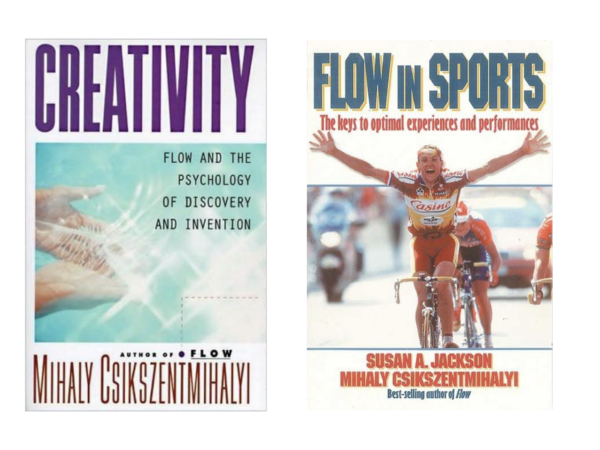
Mihaly moved on to studying chess players, rock climbers, musicians and basketball players. He asked them to describe what happened ‘when what they were doing was really going well’.
Despite coming from different fields, people reported similar experiences. Explaining this in an interview with Sarah Trevelyan, Mihaly said:
“Women who weave tapestries in the highlands of Borneo, meditating monks in Europe, also Catholic Dominican monks, and so forth. They all said these same things. So ‘flow’ seems to be a phenomenological state that is the same across cultures.
“Many of the interviewees described their feeling as ‘being carried away by a force greater than myself,’ or ‘being in a current,’ or ‘being in flow.’ I chose the last of these analogies as being the most simple.”
Let’s return to your own life and work. Looking at the activities where you enjoy a sense of flow, can you think of one you would like to build on in the future?
You may want to do this when helping people, cooking, writing, painting, designing or doing another activity. What are the reasons why you would like to pursue this activity? What would be the benefits for you and for other people?
Focus
Great workers sometimes follow their flow and translate this into a specific goal. They may aim to write an article, climb a mountain, perform a piece of music, run a marathon or do another activity. They then take the following steps.
They focus on achieving a specific goal;
They focus on the key strategies they can follow to achieve the specific goal;
They focus fully on the task they are doing when working towards achieving the specific goal.
Individuals and teams take this approach. They prepare properly and then click into action. Looking at teams, Mihaly gave the following example in his writing.
Surgeons say that during a difficult operation they have the sensation that the entire operating team is a single organism, moved by the same purpose.
They describe it as a ‘ballet’ in which the individual is subordinated to the group performance, and all involved share in a feeling of harmony and power.
Great workers commit themselves fully to the task. They often do this after doing lots of research. Bearing in mind the activity they want to pursue, they take the following steps.
They clarify the real results they want to achieve and the key strategies they can follow to achieve the goals;
They clarify the pluses and minuses involved in working to achieve the goals;
They clarify their motivation to achieve the goals and make sure it is at least 8+/10.
They then commit themselves fully to achieving the goals.
Great workers sometimes demonstrate elements of what might be called self-chosen autism. They cut-out everything else and focus fully on the piece of work.
Some cut themselves off physically by going to a specific place where they can focus on the work. Some cut themselves off psychologically by going into their own world. Some make full use of their talent by pursuing the following approach.
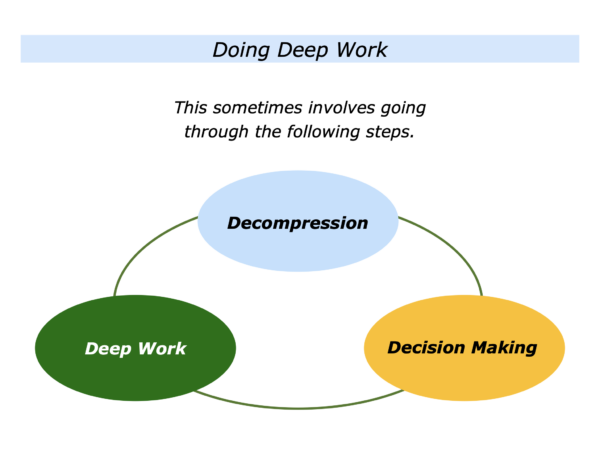
There are many ways to do deep work. This approach involves going through the following steps.
Decompression
The word decompression has many meanings. Most people associate it with a deep sea diver having to spend time in a decompression chamber to avoid getting what is known as the bends.
Some individuals also aim to decompress before embarking on doing a piece of creative work. They may slow down, sleep, walk or do other things to get into a clear state of mind.
This sometimes involves clearing themselves of any unnecessary internal or external pressures. They then feel ready to explore what for them may be the next stimulating challenge.
Decision Making
Different people choose different ways to decide on their course of action. Some let their minds drift, some sleep on things, some focus on the things that give them positive energy.
You will have your own approach to letting your mind open up and then close down on the topic you want to pursue. Bearing in mind the possible opportunities you have for going forward, you may settle on working towards a specific goal.
Great workers clarify the strategies they want to pursue and translate these into a clear action plan. You will do this in your own way. It will then be time to embark on the next stage.
Deep Work
Cal Newport’s writing has helped many people to take control of their diaries and do deep work. Here is an extract from his book that shows the benefits of doing deep work.
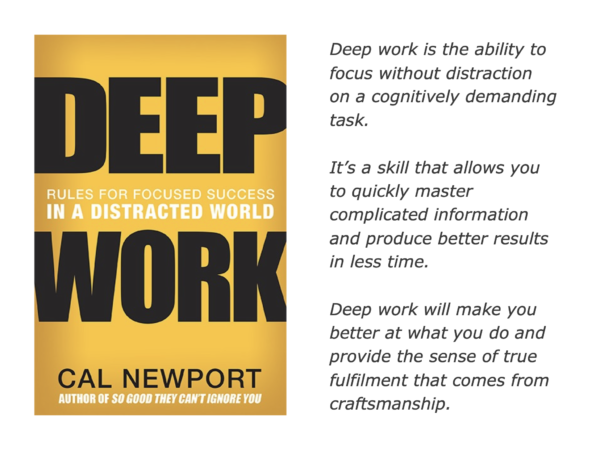
You will have your own approach to doing such work. This may include elements of the decompression, decision making and deep work approach. You may then move on to the next step.
Imagine that you are pursuing an activity where you are able to flow and focus. You may then move into action and aim to take the final step.
Fulfilment
There are many parts to taking this step. These sometimes involve focusing on doing fine work, finishing and, as a by-product, finding fulfilment. Let’s explore how you may want to follow these steps in your own way.
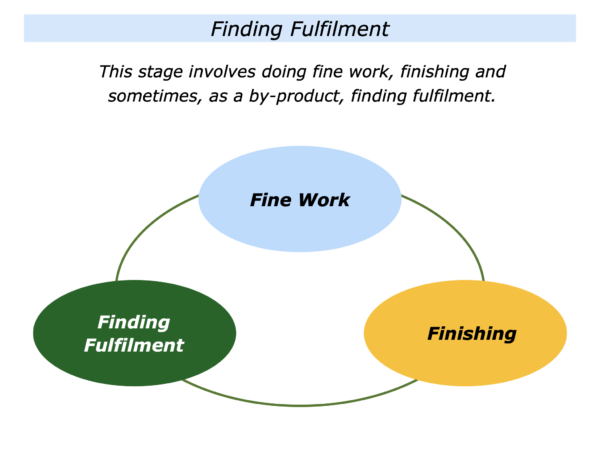
Fine Work
Imagine that you are embarking on doing a specific project. How can you do fine work? There are many definitions for such work. These include the following:
Great Workmanship … Excellent … High Quality … Very Good … Outstanding … Superior.
People who do work they care about are more likely to put their hearts into what they are doing. They may be encouraging a person, cooking food, painting, playing music, renovating a house or doing another activity.
Kahlil Gibran described this approach in his writing. Here is an extract from what he said.
Work is love made visible
And what is it to work with love?
It is to weave the cloth with threads drawn from your heart,
even as if your beloved were to wear the cloth.
It is to build a house with affection,
even as if your beloved were to dwell in the house.
It is to sow seeds with tenderness and reap the harvest with joy,
even as if your beloved were to eat the fruit.
Different people have different approaches towards finishing. One approach is for them to do their best to achieve excellence.
Ron Berger encourages students to develop the habit of delivering excellence. He wrote the following piece when working in a small school.
Fostering an ethic of excellence
For 25 years I’ve led a double life. I’m a full-time classroom teacher in a public school. To make ends meet for my family, I’ve worked during the summers, and sometimes weekends, as a carpenter.
In carpentry there is no higher compliment builders give each other than this: That person is a craftsman. This one word says it all. It connotes someone who has integrity, knowledge, dedication, and pride in work – someone who thinks carefully and does things well.
I want a classroom full of craftsmen – students whose work is strong, accurate, and beautiful; students who are proud of what they do and respect themselves and others.
In my classroom I have students who come from homes full of books and students whose families own almost no books at all.
I have students for whom reading, writing, and math come easily, and students whose brains can’t follow a line of text without reversing words and letters.
I have students whose lives are generally easy, and students with physical disabilities and health or family problems that make life a struggle.
I want them all to be craftsmen. Some may take a little longer; some may need to use extra strategies and resources. In the end, they need to be proud of their work, and their work needs to be worthy of pride.
Ron has gone on to provide teachers with many practical tools they can use to help students deliver excellence. One of the most well-known is the video called Austin’s Butterfly.
This showed how Austin, a first-grader, developed his original drawing of a butterfly. Below is a picture of his first version. This is followed by one where he had made improvements and finished properly.
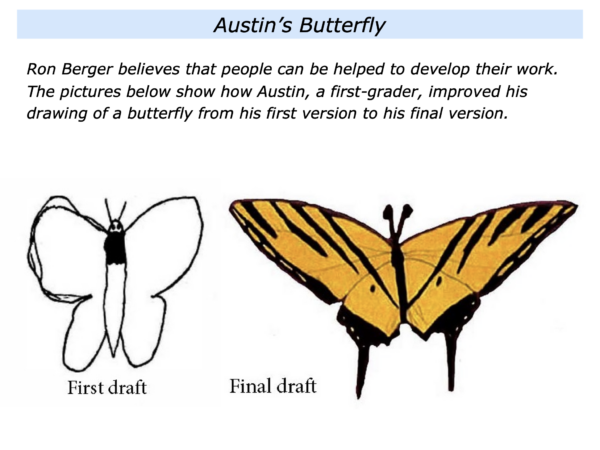
Finishing
Imagine that you are doing a piece of work. How can you finish it properly? One approach is to follow your successful pattern for finishing.
Looking back, when have you finished something properly? You may have written an article, run a marathon, renovated a house, led a team to success or done another activity.
What did you do right then to finish? What were the principles you followed? For example, you may have chosen:
To commit yourself to finishing properly … To set aside time to finish … To rehearse what you were going to do … To break down the work into manageable pieces … To set reachable goals for each work session.
To click into action … To become absorbed in the work … To keep doing the right things in the right way … To encourage yourself on the journey … To build in time for rest and recovery … To keep going until you felt satisfied you had finished properly.
How can you follow some of these principles to finish things in the future? Are there any other skills you can add? If you wish, try tackling the exercise on this theme. This invites you to complete the following sentences.
Finishing
The specific principles I have followed
to finish things properly in the past are:
*
*
*
The specific things I can do to follow
these principles – plus add other skills –
to finish things properly in the future are:
*
*
*
Finding Fulfilment
Imagine that you have done fine work and followed some of your successful principles for finishing. You may then experience a sense of fulfilment.
Sometimes this can happen during the work, sometimes at the end. Sometimes it comes from stretching yourself to reach a goal that is stimulating and achievable.
Mihaly describes people who took this path when recovering after accidents. Tragedies Transformed is the title of a study conducted by Professor Fausto Massimini who interviewed paraplegics.
Many said their accident had produced both positive and negative consequences. Tragic events presented them with extremely clear goals. Learning to live again was in itself a matter of pride.
People who mastered the fresh challenges experienced a clarity of purpose they had not felt before their accidents. Lucio had been a 20-year-old gas station attendant when a motorcycle accident paralysed him below the waist. He explained what he had done since the accident.
“When I became paraplegic, it was like being born again. I had to learn from scratch everything I used to know, but in a different way.
“I had to learn to dress myself, to use my head better. I had to become part of the environment, and use it without trying to control it. It took commitment, willpower and patience.
“As far as the future is concerned, I hope to keep improving, to keep breaking through the limitations of my handicap. Everybody must have a purpose. After becoming a paraplegic, these improvements have become my life goal.”
Franco also has paraplegia. Before his accident his most intense flow experiences came from acrobatic dancing on Saturday nights. Now paralysed from the waist down, he has set new targets. The most important goal in his life is:
“To feel that I can be of use to others, help recent victims accept their situation.”
Franco, Lucio and other paraplegics have focused on what they want to accomplish in their lives. They have set specific goals and strived to reach them on the way towards achieving their pictures of success.
The Flow Approach In Action
The flow approach is sometimes used with athletes, performers or others in certain situations. They may be playing a sport, auditioning for a musical role, giving a keynote speech or doing another activity.
The aim is to encourage them to flow rather than be paralysed by fear. Looking ahead, we focus on how they can relax, rehearse properly and then follow their rhythm.
They can aim to be positive and do their personal best. It is also to follow their principles rather than worry about the prize. The key is to emerge from the experience feeling that they have done everything possible to perform at their best.
Great workers who go into a state of flow often enjoy the journey as much as reaching the goal. They see finishing as another name for beginning.
They feel satisfied for a while but then want to focus on the next journey. They love following the principles as well as achieving the prize. Mihaly explains this approach in the following way.
The mystique of rock climbing is climbing; you get to the top of a rock glad it’s over but really wish it would go on forever.
The justification of climbing is climbing, like the justification of poetry is writing; you don’t conquer anything except things in yourself. The act of writing justifies poetry. Climbing is the same: recognising that you are a flow.
The purpose of the flow is to keep on flowing, not looking for a peak or utopia but staying in the flow. It is not a moving up but a continuous flowing; you move up to keep the flow going.
Some people aim to flow and show fighting spirit on the way to fulfilment. They take this approach rather going straight into fighting mode.
One person described how they learned to follow this approach rather than immediately getting into the boxing ring.
“Most of my life has been spent in fight mode. I have run companies where the emphasis was on selling, beating the opposition and growing every year.
“I have actually been good at fighting but there has been a price to pay. Every day was a battle and I sometimes passed this on to my family.
“One breakthrough came when helping my son who is dyslexic. At first I tried to force him to fight it but then I had a realisation.
“My son and I related best when we did activities where he was in flow. This was when were went cycling, swimming and doing other activities. At those times I relaxed and supported him.
“Bearing this in mind, I experimented by aiming to go into flow at work. I did this before channelling my fighting spirit. This worked and I am much happier for it.
“Of course, sometimes I go straight into the boxing ring but then I remind myself to slow down and flow. This is both more effective and makes everybody happier.”
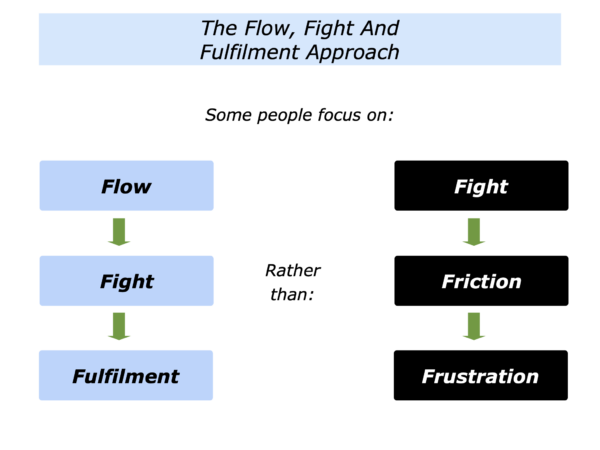
Looking ahead, can you think of a specific activity where you may want to follow the flowing approach? This could be in your personal or professional life.
You may want to do this when encouraging a person, renovating a house, playing a sport, doing a creative project, tackling a challenge or doing another activity. You may want to do this when acting as a parent, educator, medic, trusted advisor or in another role.
Looking ahead, how can you give yourself the chance to flow? How can you set things up to succeed? How can you also plan to encourage yourself on the journey?
You may set aside a block of time to do the work and follow certain rituals before moving into action. Focusing fully on the task, you may aim to follow your rhythm and do fine work. You may work for a while but then take time to recharge your batteries.
Looking ahead, you may relax, reflect and then rehearse what you are going to do next. You may then again immerse yourself fully in the task, do fine work and finish. This may then lead to having sense of fulfilment.
If you wish, try tackling the final exercise on this theme. This invites you to complete the following sentences.
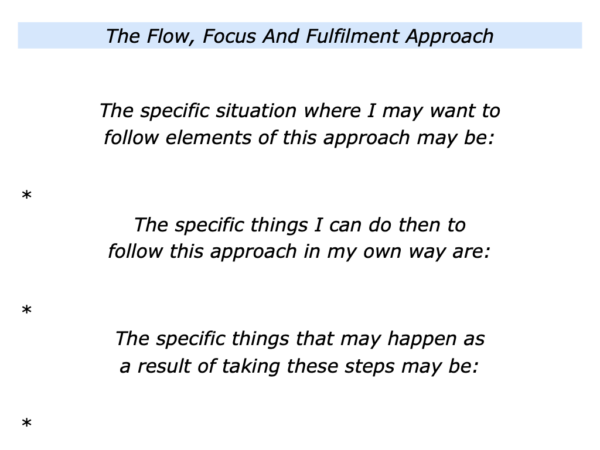






Leave a Reply